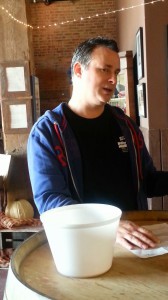Nicole Young
Repost Oct 18, 2013
Red Hook Site Visit
Today for the first time I visited a winery. I have always imagined that the only wineries that exist are far out of urban city areas. What I have always envisioned was a sea of landscaped land that had lined rows of grapes in the stages of blooming, being prepped for picking and processing; I never imagined such an exquisite role as preparing wine for fermentation and blending would be located in the backyard of the borough of Brooklyn. There are a few interesting fact that I learnt during the Red Hook site visit which I thought was quite interesting as well as important to have the background knowledge of how in-depth it is of the process of blending wines.
Mark the owner of the winery embraced our group, without hesitation, vast his knowledge of wine making along with many years of experience. There are a few interesting facts that I was able to take away from the site visit. I’ve learnt that there are some wines that won’t be placed in a barrel, and that those wines are only kept in tanks, as well as they are fermented in those tanks, it is kept cool to slow down the fermentation process. There after fermentation has completed, the wines will be bottled directly from the tank.
We were also informed that there is a difference of oaks which influences different outcome of flavors. The oak barrel provides two purposes; one is a vessel which is exposed to oxygen, which there is a great balance between oxidation and reduction, and in each barrel it is happening simultaneously. However, the lees at the bottom of the barrel basically are starving, though not actively eating sugar or making alcohol through fermentation process, it is still relevant to the process in need of oxygen, however because of the lack of oxygen, the lees causes the wine to be reduced.
Wood barrel are held together by the liquid inside and the band or hoops as they call it keeps the barrel from breaking apart; Wood is porous, which causes a lot of oxygen to get to the outside of the wine, however, there is a combination of oxidation and reduction happening at the same time in the wooden barrel.
There is a difference of flavor when different oaks are used to create the blend, texture, taste while blending and creating any outcome of wine. A neutral oak is an oak which is used over and over; which is mostly used by Red Hook winery as well as there is also new oak barrel; which isn’t so popular at Red Hook however it is still used to create a particular blend of wine. The difference of oak, is that a new oak barrel will impart oaky flavors to the taste of the wine, if indeed a new oak will be used, Red Hook winery uses a particular specific type of new oak barrel which is plunged into hot water for an extreme long time and then into clean water, which releases all the fire power in the wood; however if creating an oaky flavored wine, the process that would be to use a charred new oak barrel and put the wine inside; with a combination of using both neutral oak and new oak to create the oaky flavor it is intended for. In a barrel there is more leave contact with the wine in the barrel.
The difference of use stainless steel barrel or a tank, encourages reduction, the lack of oxygen; and it encourages a much higher contact with the lees; however if you place something in the stainless steel barrel for too long it becomes too reduced and that kind of reductive petro quality will produce a horrific taste and it will produce a smell like rotten eggs.
During the site visit we were given the opportunity to taste different wines from different years, as well as experience the difference of oak barreled wine from new to neutral as well as the difference between non fermented and fermented wine.
I haven’t been too much a fan of most of the wine I tasted during our site visit, because I have been a non-alcoholic drinker all my adulthood; however I was able to identify a particular taste that I did enjoy during our tasting experiment. I seem to enjoy wines with sweeter taste, non-dry, not too much tanning and a lot of fruit after taste and smell. One of the blended components that particularly stood out for me was RH Palab 2013 (stainless) Pinot Blanc; it was the combination of pineapple, grapefruit and banana taste, the smell of the fruits was delightful, a bit sweeter than the other blended wines I tasted, not much acidity, it had a cloudy pale shade, but very enjoyable.
Overall, this is one of my hospitality educational highlights; to be given the opportunity to experience wine tasting at a winery and learning the process of wine blending makes me much open to experience more wine tasting in the future.
Mark Synder
Founder of Co-owner of RedHook Winery
Our wonderful instructor for the winery tasting experience





The 2013 Pinot blanc was very pleasing to the palate. As a wine enthusiast i was surprised by that. I rarely sampled a wine of that caliber.
Hi Bryan I am trying to be more open to the taste of wine.. Now that I have a better understanding on the how the process is; the taste is what I am trying to get better at and appreciating it.
I also thought that all wineries are far from urban cities. I never knew that we have Red Hook Winery in Brooklyn.
RH Palab 2013 (stainless) Pinot Blanc was a wine that I really liked also. It was very light and fruity. I could not taste banana in it, but definitely could feel pineapple.